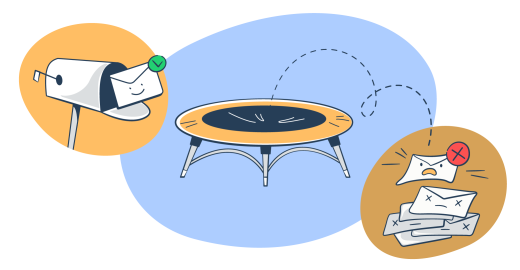In the intricate world of email marketing, crafting and executing a successful campaign is akin to an art form. It requires precision, creativity, and an understanding of the digital landscape. Despite meticulous planning, however, a common hurdle that marketers often encounter is email bounces. These bounces, if not managed effectively, can derail a campaign and impact your business's reputation. But worry not, as understanding and tackling email bounces is not as daunting as it seems. Let’s dive into the world of email bounces and uncover strategies to effectively manage them, ensuring the resilience and success of your email campaigns.
Understanding Email Bounces
At its core, an email bounce occurs when a message is undeliverable to the intended recipient’s inbox. These bounces are returned to the sender with information about the delivery failure, allowing for diagnosis and action.
There are two primary types of bounces: soft bounces and hard bounces.
- Soft Bounces - Temporary Delivery Issues:
- Service Unavailability: The recipient’s server might be temporarily down or undergoing maintenance.
- Full Mailbox: The recipient’s inbox is full, leaving no room for new emails.
- Generic Errors: Unforeseen and random errors that may resolve themselves upon re-sending the email.
Soft bounces, being temporary, are less harmful to your sender reputation, but it’s still beneficial to monitor and minimize them.
- Hard Bounces - Permanent Delivery Failures:
- Non-existent Email Addresses: The most common cause, where the email address simply doesn't exist.
- Defunct Email Servers: The recipient's email server no longer exists.
- Content Issues: Your email's content triggers security or spam filters.
Hard bounces are more problematic as they directly impact your sender reputation. It's crucial to prevent them to safeguard your ability to execute future campaigns.
Strategies for Managing and Preventing Email Bounces
Employ Email Verification Tools:
- Utilize email verification services to ensure your mailing list comprises valid, active email addresses. These tools can significantly reduce the likelihood of both soft and hard bounces.
Implement Double Opt-In Processes:
- Incorporate a double opt-in method for new sign-ups. This ensures that the email address is valid and that the recipient is genuinely interested in receiving your emails.
Personalize and Segment Your Emails:
- Tailor your emails to specific customer segments. Personalization goes beyond adding the recipient’s name; it involves sending relevant content that resonates with their interests and needs.
Improve Email Deliverability:
- Focus on both content and technical aspects of your emails to enhance deliverability. This includes using authentication protocols and avoiding spam triggers in your email content.
Consistent and Relevant Emailing:
- Maintain a consistent email schedule and ensure your content is always relevant and engaging. This practice can improve your deliverability and minimize the chance of being marked as spam.
Responding to Bounces
If your campaign encounters bounces, assess the type and cause of these bounces. For soft bounces, consider resending the email after some time. For hard bounces, immediately remove these addresses from your list to protect your sender reputation.
Summary: Harnessing the Power of Resilience in Email Marketing
Understanding and managing email bounces is pivotal in maintaining the health and effectiveness of your email marketing campaigns. By implementing these strategies, you can ensure lower bounce rates, leading to improved campaign performance, better ROI, and more accurate analytics. Embrace these practices, and you’ll transform potential email marketing challenges into opportunities for growth and success.



